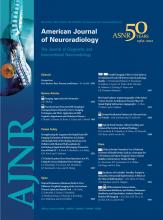Abstract
BACKGROUND AND PURPOSE: Children with shunted hydrocephalus have been undergoing surveillance neuroimaging, generally in the form of head CT, for evaluation of ventricular size. As the life expectancy of these children has improved due to better shunt technology and medical care, risks related to the ionizing radiation incurred during multiple head CT examinations that they are expected to undergo throughout their lifetime have become a concern. The purpose of this study is to estimate the LAR of developing fatal cancer due to head CT for ventricular size assessment in children with shunted hydrocephalus and to assess the impact of instituting a rapid brain MR imaging protocol in reducing radiation exposure.
MATERIALS AND METHODS: Retrospective review of medical records yielded 182 patients who underwent neuroimaging for assessment of ventricular size. Available neuroimaging studies (head CT and rapid brain MR) were counted and annual neuroimaging frequency was calculated. It was assumed that these patients undergo a similar number of neuroimaging studies annually through 20 years of age. A risk estimate was calculated based on the BEIR VII report and effective doses obtained using the International Commission on Radiologic Protection Report 103 organ weighting factors.
RESULTS: The mean annual neuroimaging study frequency was 2.1. Based on the average age of 1.89 years, it was assumed neuroimaging surveillance commences in the second year of life. LAR was calculated assuming that a patient undergoes neuroimaging in the form of head CT at this frequency (2/year) through 20 years of age. Assuming 2 scans are performed per year and the low-dose head CT protocol is used, approximately 1 excess lifetime fatal cancer would be generated per 230 patients; with standard head CT, there would be 1 excess lifetime fatal cancer per 97 patients.
CONCLUSIONS: Children with shunted hydrocephalus are at increased risk of developing fatal cancer if they are to undergo surveillance using head CT. Implementation of a rapid brain MR imaging protocol with no radiation detriment will reduce this risk.
ABBREVIATIONS:
- BEIR
- Biologic Effects of Ionizing Radiation
- CTDI
- CT dose index
- DLP
- dose-length product
- LAR
- lifetime attributable risk
- © 2012 by American Journal of Neuroradiology












